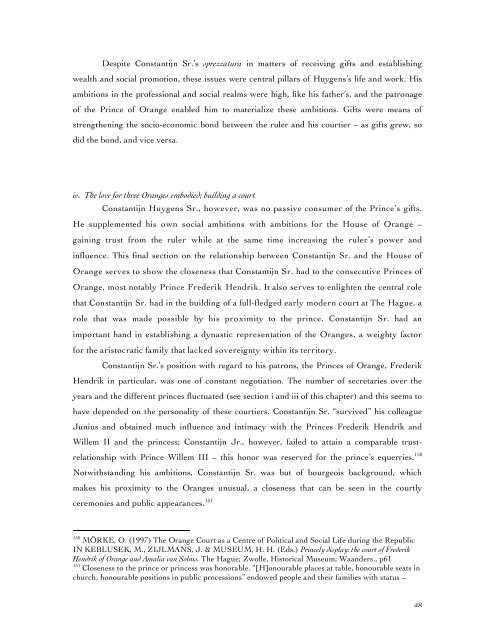Christiaan Huygens – A family affair - Proeven van Vroeger
Christiaan Huygens – A family affair - Proeven van Vroeger
Christiaan Huygens – A family affair - Proeven van Vroeger
Create successful ePaper yourself
Turn your PDF publications into a flip-book with our unique Google optimized e-Paper software.
Despite Constantijn Sr.’s sprezzatura in matters of receiving gifts and establishing<br />
wealth and social promotion, these issues were central pillars of <strong>Huygens</strong>’s life and work. His<br />
ambitions in the professional and social realms were high, like his father’s, and the patronage<br />
of the Prince of Orange enabled him to materialize these ambitions. Gifts were means of<br />
strengthening the socio-economic bond between the ruler and his courtier <strong>–</strong> as gifts grew, so<br />
did the bond, and vice versa.<br />
iv. The love for three Oranges embodied; building a court<br />
Constantijn <strong>Huygens</strong> Sr., however, was no passive consumer of the Prince’s gifts.<br />
He supplemented his own social ambitions with ambitions for the House of Orange <strong>–</strong><br />
gaining trust from the ruler while at the same time increasing the ruler’s power and<br />
influence. This final section on the relationship between Constantijn Sr. and the House of<br />
Orange serves to show the closeness that Constantijn Sr. had to the consecutive Princes of<br />
Orange, most notably Prince Frederik Hendrik. It also serves to enlighten the central role<br />
that Constantijn Sr. had in the building of a full-fledged early modern court at The Hague, a<br />
role that was made possible by his proximity to the prince. Constantijn Sr. had an<br />
important hand in establishing a dynastic representation of the Oranges, a weighty factor<br />
for the aristocratic <strong>family</strong> that lacked sovereignty within its territory.<br />
Constantijn Sr.’s position with regard to his patrons, the Princes of Orange, Frederik<br />
Hendrik in particular, was one of constant negotiation. The number of secretaries over the<br />
years and the different princes fluctuated (see section i and iii of this chapter) and this seems to<br />
have depended on the personality of these courtiers. Constantijn Sr. “survived” his colleague<br />
Junius and obtained much influence and intimacy with the Princes Frederik Hendrik and<br />
Willem II and the princess; Constantijn Jr., however, failed to attain a comparable trust-<br />
relationship with Prince Willem III <strong>–</strong> this honor was reserved for the prince’s equerries. 150<br />
Notwithstanding his ambitions, Constantijn Sr. was but of bourgeois background, which<br />
makes his proximity to the Oranges unusual, a closeness that can be seen in the courtly<br />
ceremonies and public appearances. 151<br />
150 MÖRKE, O. (1997) The Orange Court as a Centre of Political and Social Life during the Republic<br />
IN KEBLUSEK, M., ZIJLMANS, J. & MUSEUM, H. H. (Eds.) Princely display: the court of Frederik<br />
Hendrik of Orange and Amalia <strong>van</strong> Solms. The Hague; Zwolle, Historical Museum; Waanders., p61<br />
151 Closeness to the prince or princess was honorable. “[H]onourable places at table, honourable seats in<br />
church, honourable positions in public processions” endowed people and their families with status <strong>–</strong><br />
48


